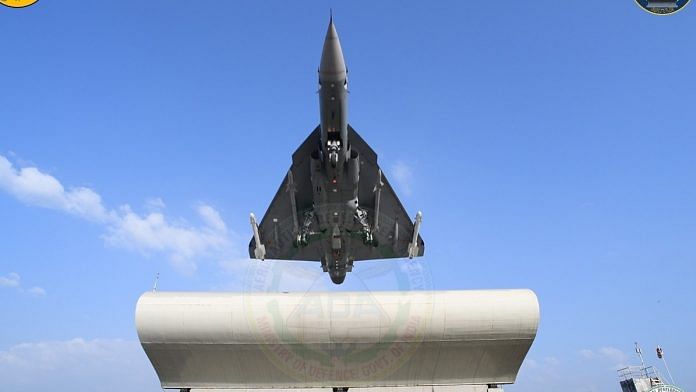New Delhi: Having successfully tested the naval version of Light Combat Aircraft (LCA) Tejas, armed with four air-to-air missiles, the Defence Research and Development Organisation (DRDO) and its Aeronautical Development Agency (ADA) now aim to pull off the aircraft’s maiden flight from India’s only aircraft carrier Vikramaditya.
The flight will serve as the ultimate technology demonstration for the Tejas even as the DRDO looks to develop a twin-engine aircraft that will become the mainstay of operations onboard aircraft carriers.
The trial, however, will take some time as a few more tests have to be carried out, DRDO sources told ThePrint.
“It (carrier-based test) is not too far. Extra safety is being taken and hence time is being consumed,” a DRDO source said.
The Navy said the project is being driven by the ADA and the DRDO, and the Vikramaditya will be made available whenever the test needs to be carried out.
Last week, in a major boost for its capability expansion, the DRDO successfully integrated the naval version of Tejas with two beyond visual range (BVR) missiles and as many close combat missiles (CCM).
One more step in launch capability expansion for LCA Navy. Two BVR plus Two CCM missiles.
— DRDO (@DRDO_India) November 29, 2019
Also Read: Here’s why former Navy chief wants India’s next Raksha Mantri to personally guide Tejas
New naval fighter in making
Even as preparations continue for the Tejas-Vikramaditya trials, the ADA and the DRDO have initiated work on designing the actual indigenous twin-engine aircraft that will fly from Indian aircraft carriers in future.
“The LCA Navy is a technology demonstrator. The naval version is very different from normal fighters because of the peculiar take-off and landing scenarios,” a Navy source said.
Unlike fighters meant for the Air Force, which has access to proper runways, naval aircraft only have limited space for take-offs and landings.
Also, unlike Air Force fighters, which come in to land with reduced power, naval aircraft arrive with full force before being stopped by arrestor wires, which are cables laid across the flight deck of a carrier.
The reason why naval fighters come in to land in take-off mode is because the aircraft would need enough power to quickly take off in case they miss the arrestor wires.
“The Navy has been clear from the very beginning that it needs a twin-engine aircraft and not single-engine because even if an engine fails, the aircraft should be able to land on the carrier,” the Navy source added.
The DRDO sources said a fresh design with a single higher-thrust engine, which meets the parameters laid down by the Navy, has been achieved.
“However, the Indian Navy has expressed that, with newly-emerging requirements, only a medium weight category twin-engine aircraft will be inducted for operations,” said another DRDO source.
“Currently, the configuration design of a twin-engine naval aircraft as sought by the user has been initiated. The initial flight-testing of this aircraft is scheduled to be carried out by 2026,” the source added.
The tests carried out so far on the shore and those planned for the aircraft carrier will provide inputs for the design and development of a twin-engine deck-based fighter (TEDBF) aircraft.
The naval Tejas is currently powered by a General Electric F404-GE-IN20 turbofan engine.
What is naval version of LCA?
Carrier-based fighters mainly come in three categories — STOVL (short take-off and vertical landing), STOBAR (short take-off but arrested recovery) and CATOBAR (catapult take-off but arrested recovery).
The LCA Navy is a STOBAR configuration aircraft that is being tested from a shore-based test facility (SBTF) at INS Hansa, Goa, to take off from a ski jump ramp with a short runway and also for arrested landings, as on-board a carrier.
The aircraft behaviour for a few seconds after ski jump take-offs, until wing-borne flight takes place, is critical to achieve a successful launch from carriers.
For the LCA, an automated ski jump take-off mode has been successfully implemented.
The indigenous fly-by-wire flight control system not only provides stability but also helps achieve an optimal take-off through the automatic ski jump take-off mode.
“About 50 ski jump take-offs have been carried out so far with various possible combinations that are likely to be done by this aircraft on-board a carrier,” a third DRDO source said.
Another challenging need of this aircraft is landing onboard carriers. Unlike in land-based aircraft, this is achieved through the arrested recovery of aircraft, which is done via arrestor cables, three of which are typically placed 12 metres apart on the deck.
On carriers, a precise landing of aircraft, each of which has an arrestor hook attached to pick up one of the cables, requires advanced flight control laws to aid the pilot.
This also demands high-strength landing gear and airframe.
“Several combinations of aircraft recovery with Arresting Gear System (AGS) at SBTF have been successfully carried out by arresting the aircraft and bringing it to a halt within 90 metres,” one of the DRDO sources said. “To date, 28 arrested landings have been successfully achieved without ever missing the arresting wire.”
For the eventuality of a miss, a “bolter mode” has been developed. DRDO sources said the bolter mode was tested thoroughly before attempting the first arrested landing.
Also Read: Why Indian Navy needs the 127 mm guns it is set to acquire for destroyers & frigates
This report has been updated to correct the full form of CCM, which is close combat missiles.



